



Agricultural transformations, growth and poverty Rob Vos FAO Director Rural Poverty Reduction UNU-WIDER 30 th Anniversary Conference Helsinki, 18 September 2015
Food Insecurity and Rural Poverty We produce enough food in the world to feed everyone.. … and the 2015 MDG 1 target of halving poverty and hunger has been met …. … yet about 1 billion continue to live in extreme poverty and 800 million people are food insecure 1 billion 800 million More than 2 food extreme billion with insecure poor micronutrient deficiency
Food Insecurity and Rural Poverty Food insecurity has declined in most countries… …yet, progress has been very uneven: 75% of poor and food insecure live in South Asia and Africa More than 75% of poor and food insecure live in rural areas, most smallholders depending on agriculture and living in lagging regions and stuck in chronic poverty Our food systems are highly inefficient and unequal To eradicate poverty and hunger will require new approaches New role for agriculture in growth strategies
Agriculture’s role in development Peter Timmer: Agriculture essential to kick start growth …. “ No country has been Initial support to unleash productivity growth able to sustain rapid But….then divert investments to industry economic growth until its citizens and No big direct impact on growth – low productivity sector investors were Share in GDP will decline over time (stylized fact) confident that food was reliably available in the main urban Traditional views led to urban bias and relative markets .” neglect of agriculture (2014 UNU-WIDER lecture)
Structural transformations Falling share agriculture in GDP and employment Decreasing contribution to growth ( but no low-productivity sector!) Widening urban-rural gaps Changing nature of agriculture in economy Consolidation landholdings, rural labour outmigration Integrated food systems, supermarket revolution Dietary transition with income and urban growth and with “supermarket” revolution (Engel’s and Bennet’s laws) Further closing in on land frontiers Nutritional gains, as well as losses (new malnutrition)
Nature of agriculture transformation matters for poverty reduction Agricultural growth more effective (more than 3 times) in reducing poverty among the poorest of the poor (in low- income countries) Agricultural labour productivity growth is critical Non-agricultural (non-extractive industry) growth more effective to reduce poverty for moderate poor (and in middle-income countries) Land access and tenure matter : slower growth and transformation process where there is “ reverse land size transition ” Geography and rural-urban linkages matter : accelerated exit from poverty through non-farm rural employment in rural townships and small cities
This time has to be different… Climate change and environmental degradation The imperative of sustainable intensification A new, green agricultural transformation is needed … with new growth opportunities … new viable options for smallholder farmers Demographic transitions and migration crisis Ageing farmers worldwide Untapped “youth power” potential ( source of distress migration) … revived roles for agricultural employment … new vision of territorial development
Sustainable structural transformations Revisit role of agriculture in growth strategies: Sustainable intensification will require massive new investments in sector Revisit role of contract farming to reshape global food value chains Potential for TFP growth and job creation (60 million according to ILO) Poorest areas: integrated agro-ecological farming on the farm and up the value chain and through extension services Smallholder farming central but needs to overcome constraints to economies of scale through rural organizations Overcoming constraints in land tenure Make youth drivers of change Pushing up both land and labour productivity Increased role for social protection Everywhere: new geography Rural territorial development New urbanization: development of peri-urban agriculture and infrastructure development for rural townships and small to intermediate cities critical to forge new rural-urban linkages
Agricultural transformations, growth and poverty Rob Vos FAO Director Rural Poverty Reduction rob.vos@fao.org
Referenced graphs and tables
FIGURE 1 The trajectory of undernourishment in developing regions: actual and projected progress towards the MDG and WFS targets Millions Percentage 1,100 45% 1,000 40% 991 908 927 900 35% 805 780 800 30% 23.3% 700 25% 18.2% 600 20% WFS target 17.3% 14.1% 500 15% 12.9% MDG target 400 10% 300 5% Number (left axis) WFS Target MDG Target Prevalence (right axis) Note : Data for 2014 – 16 in all graphics refer to provisional estimates. Source : FAO
Uneven progress Upward trend in the number of Upward trend in absolute hungry in Africa number of poor in Africa Number of people undernourished Number of Poor by Region (millions) % of World Total 30% 900 800 25% 700 600 20% India 500 China China 15% 400 India South-Eastern Asia Sub-Saharan Africa Sub-Saharan Africa 300 10% 200 5% 100 0 0% 1990-92 2000-02 2005-07 2009-11 2012-14
Future sources of growth of crop production World East Asia South Asia Latin America & Caribbean Near East & North Africa Sub-Saharan Africa 0 10 20 30 40 50 60 70 80 90 100 Arable land expansion Increases in cropping intensity Yield increases
Reverse farm size transition 25 20 % Households 15 10 5 0 Marginal High Small Off-farm Medium Medium diversification Low Large Farm size Source: Hazell (2013)
Agricultural land versus labour productivity
Recommend
More recommend